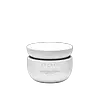What's inside
What's inside
 Key Ingredients
Key Ingredients

No key ingredients
 Benefits
Benefits

 Concerns
Concerns

 Ingredients Side-by-side
Ingredients Side-by-side

Water
Skin ConditioningHoney
HumectantOlea Europaea Fruit Oil
MaskingSimmondsia Chinensis Seed Oil
EmollientAloe Barbadensis Leaf Juice
Skin ConditioningStearyl Alcohol
EmollientCetyl Alcohol
EmollientStearamidopropyl Dimethylamine
EmulsifyingGlutamic Acid
HumectantParfum
MaskingBenzyl Alcohol
PerfumingEDTA
Cyclopentasiloxane
EmollientDimethicone
EmollientMethylchloroisothiazolinone
PreservativeMethylisothiazolinone
PreservativeWater
Skin ConditioningCetearyl Alcohol
EmollientPropanediol
SolventHydrogenated Ethylhexyl Olivate
EmollientButyrospermum Parkii Butter
Skin ConditioningBehentrimonium Chloride
PreservativeLactobacillus
Skin ConditioningAstrocaryum Murumuru Seed Butter
EmollientOlea Europaea Fruit Oil
MaskingSodium Hyaluronate
HumectantSqualane
EmollientAdansonia Digitata Seed Oil
EmollientArgania Spinosa Kernel Oil
EmollientBoswellia Carterii Resin Extract
MaskingHyssopus Officinalis Leaf Oil
Skin ConditioningMoringa Oleifera Seed Oil
EmollientNigella Sativa Seed Oil
EmollientOrbignya Speciosa Kernel Oil
EmollientCitrullus Lanatus Seed Oil
EmollientHydrogenated Olive Oil Unsaponifiables
EmollientHelianthus Annuus Seed Extract
Skin ConditioningC9-12 Alkane
SolventCetrimonium Chloride
AntimicrobialPolyquaternium-10
Stearalkonium Chloride
PreservativeCetyl Hydroxyethylcellulose
Emulsion StabilisingPhytic Acid
Caramel
Cosmetic ColorantCoco-Caprylate/Caprate
EmollientCitric Acid
BufferingParfum
MaskingPotassium Sorbate
PreservativePhenoxyethanol
PreservativeDipropylene Glycol
HumectantStearyl Alcohol
EmollientSilica Dimethyl Silylate
EmollientHydrated Silica
AbrasiveSodium Phosphate
BufferingDisodium Phosphate
BufferingTocopherol
AntioxidantLinalool
PerfumingWater, Cetearyl Alcohol, Propanediol, Hydrogenated Ethylhexyl Olivate, Butyrospermum Parkii Butter, Behentrimonium Chloride, Lactobacillus, Astrocaryum Murumuru Seed Butter, Olea Europaea Fruit Oil, Sodium Hyaluronate, Squalane, Adansonia Digitata Seed Oil, Argania Spinosa Kernel Oil, Boswellia Carterii Resin Extract, Hyssopus Officinalis Leaf Oil, Moringa Oleifera Seed Oil, Nigella Sativa Seed Oil, Orbignya Speciosa Kernel Oil, Citrullus Lanatus Seed Oil, Hydrogenated Olive Oil Unsaponifiables, Helianthus Annuus Seed Extract, C9-12 Alkane, Cetrimonium Chloride, Polyquaternium-10, Stearalkonium Chloride, Cetyl Hydroxyethylcellulose, Phytic Acid, Caramel, Coco-Caprylate/Caprate, Citric Acid, Parfum, Potassium Sorbate, Phenoxyethanol, Dipropylene Glycol, Stearyl Alcohol, Silica Dimethyl Silylate, Hydrated Silica, Sodium Phosphate, Disodium Phosphate, Tocopherol, Linalool
Ingredients Explained
These ingredients are found in both products.
Ingredients higher up in an ingredient list are typically present in a larger amount.
Olea Europaea Fruit Oil is the fixed oil obtained from the ripe fruit of the Olive. In other words - olive oil.
The primary contents of olive oil are glycerides of the fatty acids linoleic, oleic and palmitic.
Olive oil also contains antioxidants such as Vitamin E. Antioxidants may help reduce signs of aging by fighting unstable free-radical molecules. It also contains Vitamins A (retinol), D, and K.
The squalene in olive oil makes it a great emollient. Emollients help soothe and soften your skin by trapping moisture in. This makes olive oil a great skin moisturizer.
Studies show olive oil to have antibacterial and antifungal properties in low concentrations. Another study found olive oil irritated sensitive oily skin. We always recommend speaking with a professional about using this ingredient in your routine.
Due to the fatty acid content, this ingredient may not be fungal-acne safe.
Learn more about Olea Europaea Fruit OilParfum is a catch-all term for an ingredient or more that is used to give a scent to products.
Also called "fragrance", this ingredient can be a blend of hundreds of chemicals or plant oils. This means every product with "fragrance" or "parfum" in the ingredients list is a different mixture.
For instance, Habanolide is a proprietary trade name for a specific aroma chemical. When used as a fragrance ingredient in cosmetics, most aroma chemicals fall under the broad labeling category of “FRAGRANCE” or “PARFUM” according to EU and US regulations.
The term 'parfum' or 'fragrance' is not regulated in many countries. In many cases, it is up to the brand to define this term.
For instance, many brands choose to label themselves as "fragrance-free" because they are not using synthetic fragrances. However, their products may still contain ingredients such as essential oils that are considered a fragrance by INCI standards.
One example is Calendula flower extract. Calendula is an essential oil that still imparts a scent or 'fragrance'.
Depending on the blend, the ingredients in the mixture can cause allergies and sensitivities on the skin. Some ingredients that are known EU allergens include linalool and citronellol.
Parfum can also be used to mask or cover an unpleasant scent.
The bottom line is: not all fragrances/parfum/ingredients are created equally. If you are worried about fragrances, we recommend taking a closer look at an ingredient. And of course, we always recommend speaking with a professional.
Learn more about ParfumStearyl Alcohol is a type of fatty alcohol from stearic acid. It is a white, waxy compound used to emulsify ingredients.
Fatty Alcohols are most often used as an emollient or to thicken a product. Emollients help soothe and hydrate the skin by trapping moisture.
They are usually derived from natural fats and oils and therefore do not have the same drying or irritating effect as solvent alcohols. FDA allows products labeled "alcohol-free" to have fatty alcohols.
Learn more about Stearyl AlcoholWater. It's the most common cosmetic ingredient of all. You'll usually see it at the top of ingredient lists, meaning that it makes up the largest part of the product.
So why is it so popular? Water most often acts as a solvent - this means that it helps dissolve other ingredients into the formulation.
You'll also recognize water as that liquid we all need to stay alive. If you see this, drink a glass of water. Stay hydrated!
Learn more about Water